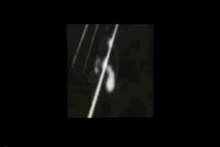Monkeyshines
| Movie | |
|---|---|
| Original title | Monkeyshines |
| Country of production | United States |
| Publishing year | 1890 |
| length | 5 seconds |
| Rod | |
| Director | William KL Dickson |
| production | William KL Dickson |
| camera | William KL Dickson William Heise |
| occupation | |
| |
| chronology | |
|
Successor → |
|
Monkeyshines is believed to be the first film to be shot in the United States . It is an experimental film designed to test an early version of the Edison Laboratory's kinetograph . The film was directed by William KL Dickson and William Heise .
action
The film, which only lasts a few seconds, shows a blurry white figure performing large gestures.
Production history
Since 1887 Thomas Alva Edison worked on the idea of developing a device that could record and play back “moving images”. The Scottish engineer William KL Dickson was commissioned with the development work on the device called the kinetoscope in the fall of 1888, and he was able to bring the necessary experience as an amateur photographer. Analogous to the Edison phonograph , on which music and speech could be recorded on a wax roller, Dickson first constructed a device with which single images could be recorded on a specially prepared roller.
Edison had already filed a description of the apparatus with the US patent office in 1889 . In 1896 he submitted three films to the patent office as proof of the functionality of the cylindrical film camera after his patent claims for the invention of the kinetoscope were questioned. These films are Monkeyshines No. 1, 2 and 3, which were only intended for internal testing and were never shown in public; all they should do is check the new camera system.
It is not yet scientifically clear whether Monkeyshines No. 1 was filmed in 1889 with John Ott or in 1890 with G. Sacco Albanese as the actor. Both were employees of the laboratory and there is evidence for both variants. While film historian Paul Spehr suggested that Dickson Monkeyshines No. 1 produced in June 1889, Dickson biographer Gordon Hendricks refers to Dickson's own notes that the film was made in November 1890. Film historians like Charles Musser or David Robinson confirm Hendricks dating.
Shortly after the Monkeyshines films were completed, Edison and Dickson abandoned the idea of the cylindrical arrangement of the footage and instead worked with roll film . In May 1891, a prototype of the kinetoscope was finally completed, with which Edison prepared the commercial use of the invention.
The Monkeyshines filmstrips submitted by Edison in 1896 are now in the Library of Congress .
literature
- Charles Musser: Edison Motion Pictures, 1890–1900: An Annotated Filmography . Smithsonian Institution Press, Washington, DC 1997, ISBN 88-86155-07-7 .
- David Robinson: From Peep Show to Palace: The Birth of American Film . Columbia University Press, New York 1996, ISBN 0-231-10338-7 .
Web links
- Monkeyshines 1-3 on YouTube
- Monkeyshines, No. 1 in the Internet Movie Database (English)
- Monkeyshines, No. 2 in the Internet Movie Database (English)
- Monkeyshines, No. 3 in the Internet Movie Database (English)
- Monkeyshines, No. 1 in the online film database
- Monkeyshines, No. 2 in the online film database
- Monkeyshines, No. 3 in the online film database
- Entry in the Progressive Silent Film List (English)
Individual evidence
- ^ David Robinson: From Peep Show to Palace , p. 29.
- ^ Charles Musser: The Emergence of Cinema: The American Screen to 1907 . University of California Press, Berkeley 1994, ISBN 0-520-08533-7 , p. 503.
